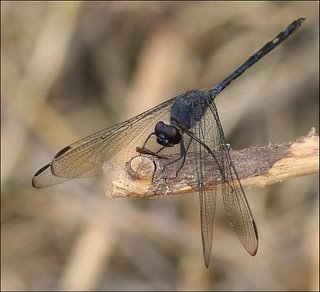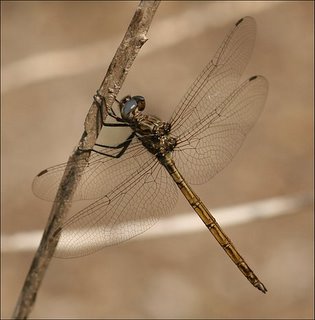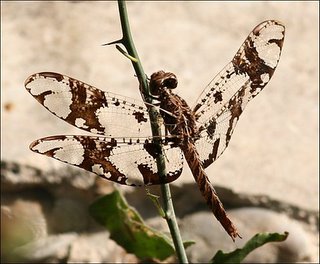
Stylurus and I have made more than one holiday trip to the Lower Rio Grande Valley of Texas to enjoy the birds, butterflies, and dragonflies. Even in late fall and winter, you never know what you might find there, and often there are rarities of all these taxa.
Of course, the weather is always better there than here, and this weekend was no exception. We left Michigan in a howling snowstorm with the temps about 15 degree F. The Valley was sunny and hot, hotter than any of our previous November visits. That meant ponds, ditches, and the Rio Grande were buzzing with odonata!
We looked for odonata at several locations, primarily Santa Ana National Wildlife Refuge (SANWR), Bentsen-Rio Grande Valley State Park/World Birding Center, Edinburg Scenic Wetlands, and along the Rio Grande at Salineno. We ended up with over two dozen species, which is quite respectable for this time of year:
American Rubyspot (
Hetaerina americana)
Common Spreadwing (
Lestes disjunctus)
We are still examining some photos of another female
LestesBlue-fronted Dancer (
Argia apicaulis)
Blue-ringed Dancer (
A. sedula) –
According to both Abbott's great book, Dragonflies and Damselflies of Texas and the South-Central States, and his web site, Odonata Central, a late date for the region. We had at least a half dozen along the irrigation canal at Bentsen.Dusky Dancer (
A. translata)
Double-striped Bluet (
Enallagma basidens)
-- One male along the irrigation canal at Bentsen; late date.Familiar Bluet (
E. civile)
Neotropical Bluet (
E. novaehipaniae)
-- A lifer for us. I picked it out of a spider web at Salineno so I was able to confirm the ID later.Rambur’s Forktail (
Ischnura ramburii) –
We photographed one interesting blue-thoraxed male along the irrigation canal at Bentsen.Caribbean Yellowface (
Neoerythromma cultellatum)
- A lifer, a pair in tandem along the irrigation canal at Bentsen; late date. These were super-cool. Wish we could have gotten a photo (without falling in the canal). Desert Firetail (
Telebasis salva)
C
ommon Green Darner (
Anax junius)
Black Setwing (
Dythemis nigrescens) --
Quite common, handsome little guys like the one pictured above.Pin-tailed Pondhawk (
Erythemis plebeja)
– One male at the ponds near the front entrance of SANWR; late date by over a month.Eastern Pondhawk (
Erythemis simplicollis)
 Straw-colored Slyph
Straw-colored Slyph (
Macrothemis inacuta) --
A lifer for us, seen two days in a row at the very dry, waterless old manager's residence at SANWR. Also late by over a month. It finally posed for a photo, above.Spot-tailed Dasher (
Micrathyria aequalis) –
Also quite late.Thornbush Dasher (
Micrathyria hageni)Roseate Skimmer (
Orthemis ferruginea)
Blue Dasher (
Pachydiplax longipennis)
Wandering Glider (
Pantala flavescens)
Eastern Amberwing (
Perithemis tenera)
– One female along irrigation canal at Bentsen was also a little late.Filigree Skimmer (
Pseudoleon superbus) –
This stunning ode was not a lifer, as we had seen one at SANWR two years ago. Theoretically, there really isn't great breeding habitat (noted as desert ponds and slow streams) in the vicinity for them, and they are thought to be vagrants. This time, we saw four individuals at SANWR, none of which were near water. The female below was also at the old manager's residence, where we had nine different odonata species! Abbott lists no dates past late August. Variegated Meadowhawk (Sympetrum corruptum
Variegated Meadowhawk (Sympetrum corruptum)
Black Saddlebags (
Tramea lacerata)
Red Saddlebags (
T. onusta)
Many of these late dates mostly reflect the lack of work in the Valley at this time of year. With the addition of Josh Rose on the staff of the World Birding Center, this should change. Josh is great with birds, getting a crash course in rare Texas butterflies, has a keen interest in beetles and other insects, and is a very enthusiastic odonatist, having worked on them for his PhD. He is leading regular dragonfly walks at Bentsen, and is sure to find many more interesting odes in the months to come. He's not only knowledgeable, but friendly and generous with his time. Thanks for your help, Josh!









